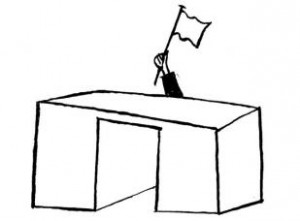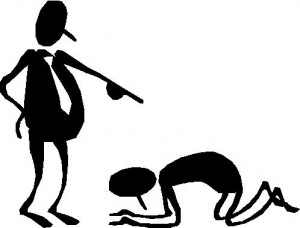Workplace bullying or worker abuse?
February 17th, 2013 | Published in Bully power, Favorites
Bullying is a busy term, and people use it to describe all sorts of behaviour between all sorts of people in all sorts of situations. It is spread very thin, but at the same time does not convey enough about the operation of power, obscuring direction in hierarchical structures, and blurring distinctions between formal and informal sources. In other words, it needs to be contextualised.
These are not trivial shortcomings, and in this post I am going to look at some of the fuzziness of the concept, and some of the consequences of that fuzziness, and suggest an alternative way of describing part of what goes down in workplaces, particularly the part involving abuse of hierarchical power.
Bullying at City Council
One recent situation that stretched the meaning of bullying beyond credibility for me involved allegations and counter-allegations between public figures at a City Council: the Mayor accused a Councillor of bullying the CEO; the Councillor accused the Mayor of bullying her. I was curious enough to try to find out more. I didn’t find much except that the Mayor and Councillor appear almost on a par at the peak of the organisational pyramid, and the CEO is slightly below both.
This situation does not fit my images of bullying, although these three are undoubtedly out to discredit each other (two of them were on competing teams for Council elections). Self-interest, sabotage, ruthlessness, and treachery might be more to the point.
Good luck to whoever has to adjudicate, I thought, and who would that be anyway? Who is in a position to discipline three such people at the top of an organisation? And, while they are busy deflecting attention from themselves by accusing each other of bullying, you might wonder how they are treating those below them in the hierarchy. Some of the toxicity would surely be spilling downwards. Is that also to be called bullying? Whatever; the chances seem slim of it being dealt with effectively, at least by appeal up the line – which is where workers are usually expected to take their grievances. Rough justice if that is the source of the problem.
Workplace bullying elsewhere
While pursuing the Council story, I came across other stories about workplace bullying, including reference to a report that 95% of school staff experience bullying, as well as more than seventy percent of health professionals, large proportions of public servants, police, and the armed forces. Goodness, I wondered, who can possibly be doing all this bullying? Following the trail a little further, it appears that a high proportion is seen to occur between colleagues, as well as being perpetrated by students towards teachers, or staff towards more senior staff.
No doubt colleagues can behave badly towards each other, and students and workers can obstruct authority, but to call all such behaviour bullying, alongside what is happening at City Council, is stretching the meaning towards meaninglessness. These examples are all over the place in terms of hierarchical power; upwards, downwards, sideways – no matter, it is all generically labelled as bullying.
 Definitions of bullying are often couched in terms of relationships, or as repeated, unacceptable, deliberate behaviours that may cause harm. If they mention power, it is of the form of social influence rather than the structural variety embedded in workplace hierarchies. In other words, the concept does not differentiate between the CEO’s treatment of the receptionist and the receptionist’s treatment of the CEO even though, in the event of dispute between these two, the CEO is much more likely to have access to legal advice, paid for by an organisation that predictably closes ranks around its highly paid executive. The interests of the CEO are more likely to prevail.
Definitions of bullying are often couched in terms of relationships, or as repeated, unacceptable, deliberate behaviours that may cause harm. If they mention power, it is of the form of social influence rather than the structural variety embedded in workplace hierarchies. In other words, the concept does not differentiate between the CEO’s treatment of the receptionist and the receptionist’s treatment of the CEO even though, in the event of dispute between these two, the CEO is much more likely to have access to legal advice, paid for by an organisation that predictably closes ranks around its highly paid executive. The interests of the CEO are more likely to prevail.
Blowing the whistle on those at the top can be a fast route to unemployment, most likely on some pretext other than the whistleblowing. I have, however, come across one story in which a group of industrial laundry workers acted collectively against an abusive manager (who was referred to in court, and in the media, as a bully). The end result has hopefully been good for the workers, although a lot of damage might have been avoided if the manager had been held to account much earlier.
Worker abuse is directional
Describing a situation as workplace bullying does suggest something is not quite right in a workplace but, as previous examples illustrate, it is vague – too vague when the problem is abusive management. In such cases, it would be clearer to use a different term, one embodying the concept of abuse of hierarchical power.
One such alternative is worker abuse. This concept has appropriate directionality – downwards in hierarchical structures, not upwards or sideways – and shares that directionality with concepts like racism, sexism, and ableism. I know white people sometimes believe they have experienced racism, and men sometimes feel they are at the receiving end of sexism, and the boss may feel abused by a subordinate (although I have never heard any ablebodied person claim to have experienced ableism, which is interesting in itself) but I would argue that these terms (racism, sexism, ableism, and worker abuse) need to be put into social context and understood in relation to divisions of structural power. At the broader social level, white people, men, the ablebodied, and bosses (as classes or groups) occupy positions of relative privilege compared with nonwhite people, women, those with disabilities, and workers.
I will come back to this knotty issue of who can be at the receiving end of what in a subsequent post, but for now my shorthand position can be expressed by example: a CEO is in a position to abuse the power held over a worker, but the reverse does not hold; the CEO cannot claim to be a victim of worker abuse by someone lower on the organisational chart.
The issue of directionality is central to my rationale for introducing worker abuse as a formal concept. Compared with bullying, it is precise in its implication of directionality, thus making the operation of hierarchical power more visible, and ultimately, I hope, more accountable. If the situation at the laundry had been identified in its early stages as worker abuse, the manager may have been dealt with in a timelier manner.
Making hierarchical power visible and accountable
The greater the hierarchical power a role entails, the more potential there is for abuse, but the less accountability there may be in behavioural, ethical, and moral terms. Plenty of people are happy to tell kids, or workers, what they should and shouldn’t do, but fewer are in a position to tell the Mayor, the Bishop, the General, or the CEO to take a good hard look at the way they exercise power. As a general rule those at the top are left to get on with the job of running the show – unless they are caught with their hands in the till.
 One-size-fits-all concepts of bullying make it easier for relatively powerful personnel to define situations to suit their vested interests. So, for example, trouble might be pre-empted or deflected by turning the tables and problematising workers instead. A whole raft of terms becomes available for such purposes including finding workers to be uncooperative, unreliable, difficult, insubordinate, unprofessional, unethical and, of course, poor team players and troublemakers. Once the situation has been defined in such terms, it becomes more difficult for workers to get a fair hearing within or beyond the organisation. I have felt much frustration seeing rank and file workers lose jobs on the basis of tired tactics from the top.
One-size-fits-all concepts of bullying make it easier for relatively powerful personnel to define situations to suit their vested interests. So, for example, trouble might be pre-empted or deflected by turning the tables and problematising workers instead. A whole raft of terms becomes available for such purposes including finding workers to be uncooperative, unreliable, difficult, insubordinate, unprofessional, unethical and, of course, poor team players and troublemakers. Once the situation has been defined in such terms, it becomes more difficult for workers to get a fair hearing within or beyond the organisation. I have felt much frustration seeing rank and file workers lose jobs on the basis of tired tactics from the top.
If hierarchical power is part of the context of workplace disputes it also needs to be built in to attempts at resolution. Worker abuse, as a concept, makes the operation and direction of power visible and open to challenge, thus levelling the playing field, or at least making it obvious that it was not level to start with.
Raising awareness of victim-blaming
It still seems remarkably commonplace to blame the victim in workplace situations in ways that would be largely unacceptable if the issue was sexual abuse or domestic violence. Provocation-style narratives are still trotted out in rape cases, but they are, in my experience, more likely to be recognised and confronted than if the abuse is located in a workplace. A rapist who described his victim as leading him on, or wanting it, for example, would not remain unchallenged for long. That is as it should be – and as it also should be in relation to worker abuse. My guess is that the inconsistency reflects relative lack of awareness about abuse of power in workplaces; my argument is that this needs to change. I would like to see zero-tolerance of all forms of victim-blaming, including in workplaces, and broad commitment to developing and refining ways of achieving this goal.
In the end
Workplace bullying is not specific enough to convey abuse of power in hierarchical workplaces. Worker abuse is a more useful concept in such situations. It is (downwardly) directional, making power more visible, and hence potentially more accountable. It invites challenge to dominant narratives that blame the victim and prop up the vested interests of those at the top. A first step in creating change would be to raise awareness about abuse of hierarchical power in workplaces, and start referring to it as worker abuse. Worker abuse contextualises a significant component of what is normally referred to as workplace bullying.





Additional link of interest, sent to me by Abby Shovlin, who contacted me in April 2019 expressing interest in “Swimming with Sharks” that she learnt of through my comment on the article. Hard copy of book posted to her. https://www.theguardian.com/money/us-money-blog/2014/jul/06/bullying-at-work-political-experiences-bullies-solutions
Thanks, Lorraine, and yes, my main interest in this piece was to start deconstructing the term ‘bullying’ rather than to replace it in any blanket way. Clearly, not all bad behaviour/bullying in workplaces can be described as worker abuse in the sense I am using that term (with its implication of abuse of structural power), but it is one category that I think warrants particular attention. Also, if you have a link to your thesis, it would be good to have so that people can follow up. I could also include it on the Resources page of the website, which is an area I have not paid nearly enough attention to yet.
Thought provoking term ‘worker abuse’. I see the merit in discussing power relationships in the work place and the top down power of managers, representing the employer, over workers as employees. My recent PhD research found more bullying from managers than colleagues. However my thoughts about the term workplace bullying is that it still has a place in an OH&S framework as one cannot start from the premise that all bullying is top down.
I agree, that it’s time to dig further into our workplace culture and question accountability (or lack thereof?); the hierarchical management model (what level-playing field?); victim-blaming (could that be “projection”?) and redefine the parameters, so thank you Joan for your well-formed and well-informed post, tackling this abusive yet commonplace, even socially accepted behaviour.
Dominating characters commonly referred to as bullies, have been around since I can remember, yet in my naivety I thought (and hoped) I’d left them behind in the school ground. But alas, I was wrong, and the longer I have been part of the workforce, the more I realise that the adult version of self-glorification is alive and well, screaming for attention to be taken seriously. So herewith a few lines from my book The Other Side of the Ledger where a one-directional “abuser” lurks in the background.
P28 – “The inevitable buzz and hum of the day rises as the “team” arrives and says their good mornings. It’s Virginia’s turn today to warn them that their leader is in one of those moods and that it’s going to be one of those days. One of those days where everyone feels as though they’re walking on eggshells; waiting for inevitable cracks and slippery yolks to coagulate and congeal like an ugly shadow; an ugly shadow that casts doubt in the individual, creates disharmony in the team, and undermines the corporate structure” …
To read another excerpt from my book, visit
http://www.palmerhiggsbooks.com.au/index.php/the-other-side-of-the-ledger.html
Thanks, Ruth. It does actually seem there is a bit more activity and interest in this area than I thought. You are coming from a somewhat different perspective and I’ve also just been watching a YouTube video of a professor, Richard Wolfe, in the USA talking about what he calls “Democracy at Work” and arguing it’s essential as a response to the global financial crisis. All very interesting, and feels like a valuable conversation to be having.
Good stuff Joan and agree that the “power dynamics” that operate in contemporary workplaces need to be defined and deconstructed if we envisage and aspire to working in democratic workplaces. In Australia we all get to vote every 3 years but how many of us can actively participate in the decisions that affect our lives everyday at the workplace? What then is democracy?
I think that’s an excellent point, Rui, about voting rights. I have had related thoughts about things like performance appraisals. That is, why is it that it they only go in one direction – down the hierarchy, and not upwards? Staff surely have legitimate things to say about management that could improve the quality and health of workplaces, but nobody seems to take that seriously as an idea. Keep working on it, I guess.
TOKEN ATTEMPT AT BALANCE
The linked article is written from an employer perspective, and I don’t think much of any of it, but thought to demonstrate at least token recognition of the concept of ‘balance’ having recently put my own perspective in this post. Perhaps the one point of agreement is that bullying is a fuzzy concept, which means that it can be coopted by vested interests. The vested interests I am most concerned by, however, are those with the power to hire and fire.
http://www.theage.com.au/small-business/bogus-or-not-bullying-claims-are-costly-20130224-2ezgi.html